Acrylic paint blending is a technique of smoothing out transitions between different colors or shades in a painted surface to create a seamless and uniform appearance. Blending acrylics aims to form a harmonious color scheme and produce a more natural and visually pleasing look.
Blending acrylic paints is an exciting and satisfying way to produce attractive pieces of art. Whether you are a seasoned artist or just starting out, blending opens up a world of creative possibilities for you. But the question is, “How to blend acrylic paint?”
For this, you need to use a brush or palette knife to mix colors on the canvas or palette, add water to thin the paint, and overlap wet brushstrokes to blend. There are multiple techniques, such as dry-brushing, scumbling, stippling, and glazing, to achieve a smooth and seamless blend.
In the blog post, I’ll discuss all the possible ways used to blend acrylic paint. As a passionate artist and associate professor at the School of Arts, Houston, I’ve trained several students with these blending techniques. So if you’re a beginner, don’t worry; I’m here with this post to explain every crucial detail to you.
12 Ways How To Blend Acrylic Paint For Beginners?
You’ll find numerous blogs and tutorials on how to blend acrylic paint on canvas, paper, or another such surface on the internet. Even a beginner-level person can learn and practice these strategies if he/she is guided in the right way.
The following blending acrylic paint techniques are really effective, practical, and easy to learn.

Dry-Brushing
What is dry brushing? It is a painting technique where a dry paintbrush is used to apply a minute amount of paint to canvas or another surface in order to produce a textured, rough, or weathered effect.
This technique is usually used in the formation of textures in landscapes or in weathering models and miniatures.
How to blend colors when painting using dry brushing?
- Choose two colors of choice you want to blend.
- Load a good quality dry brush with the first color.
- Lightly touch the surface with the brush and remove most of the paint on a paper towel.
- Recount the same procedure with the second color.
- Use the dry brush to blend the two colors together on the surface, starting from one corner and slowly working towards the other.
- Repeat the process as required to attain the desired level of blending.
Tips: The key to successfully blending colors with dry brushing is to use light, controlled strokes and to have a very dry brush.
Wet-On-Wet Technique
What is wet on wet blending? It is a painting technique in which wet paint is employed on top of wet paint. This enables you to easy blending and mixing of colors. This helps you create a smoother and more fluid appearance compared to conventional layering techniques.
The downside to using this method for blending is you have to be very fast and efficient as the paint dries fast. You have to blend the colours when they are still moist.
How to blend paint together with the wet-on-wet method?
- You need to begin with a wet canvas or surface.
- Now apply a base color and allow it to soak in for a few moments.
- Immediately, add another color on top of the previous one and blend it with the first color as you proceed.
- Use a brush to blend the colors together while they are still moist.
- Repeat the steps as required to build up the desired effect.
Tips: Wet-on-wet blending works best with thin, fluid acrylic paints. You may also use a spray bottle filled with water to moisten the paint to extend the drying time of the paint.
Note: There is another same method called wet-on-dry blending, where a wet coating of paint is applied over a dry-painted surface. The procedure is similar to wet on wet method, so I’m not going deep into that. Both of these methods are also called water blending acrylic painting.
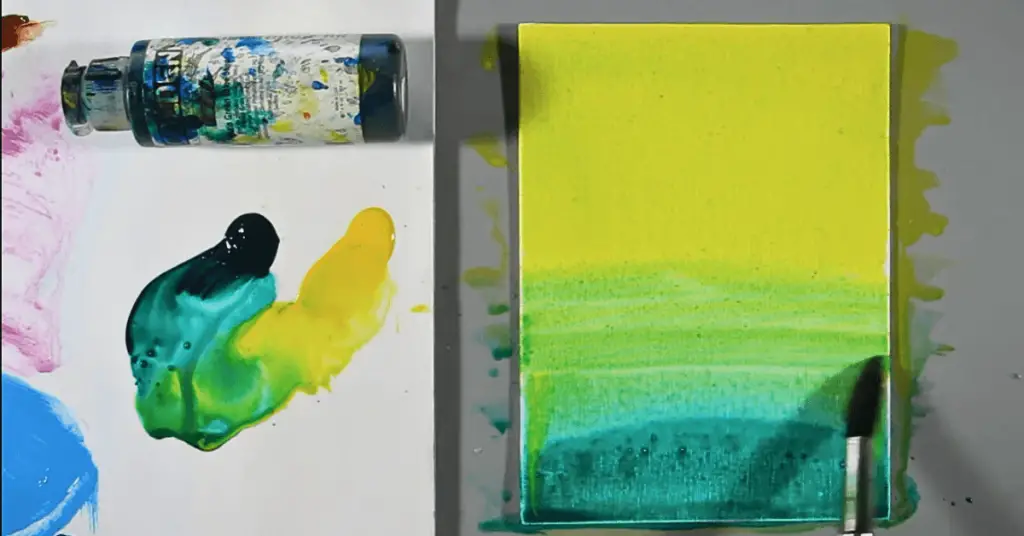
Scumbling Technique
What is scumbling blending? It is a painting technique in which a thin layer of paint is lightly dragged over a dry underlayer to create a hazy and fragmented effect. I really love using this technique when I’ve to blend the paint for a white or light-coloured background.
It can also be used in acrylic painting to produce a soft texture surface. Additionally, it works well with forming depth and attraction to a painting.
Scumbling can be done with a brush or a palette knife and can be applied to a vast number of subjects, from landscapes to portraits.
How to blend acrylic paints with scumbling?
- The very first step is starting with a base color already applied to your surface.
- Now, take another color and load a dry brush with it.
- Using light and circular motions, lightly drag the brush over the base color, allowing some of the base layer to show through the thin coating of the new layer.
- You may repeat the process with additional colors as per your requirements, layering and blending them in the same way.
- Keep adding colors until you acquire the desired effect, and proceed with blending by scumbling until all the colors are seamlessly mixed together.
Tips: Always use a dry brush for scumbling, and ensure the bristles of your brush are not too moist because this can cause the colors to mix too much, creating an unbalanced appearance.
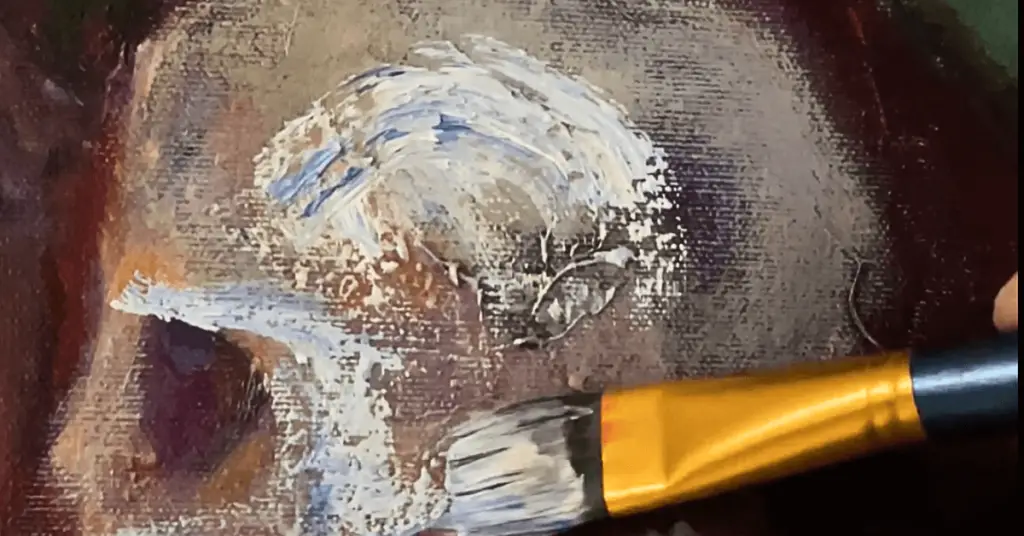
Stippling Technique
What is stippling? It is a technique used in drawing and painting to create a shading effect by using small contrasting color dots. The dots can be blended in many ways to produce wonderful artwork.
This technique is also used in comic book illustrations and cross-hatching to put together texture and dimension in images.
How to blend with acrylic paint using the stippling technique?
- Load a stippling brush with acrylic paint and tap it onto a surface to remove excess.
- Dab the brush onto the canvas or paper sheet in a random pattern to spread the color in dots on the surface.
- Now, take another color on the brush and do the same, slightly overlapping the first doped layer.
- The next step is taking a fine-haired brush and beginning layering and blending these dots until you achieve the desired result.
- Finally, soften the edges by stippling them with a dry brush.
Tips: Stippling is an excellent technique for abstract, realistic art and blending colors, but it can also be time-consuming. Experiment to find the controllable and appropriate brush and practice more on rough surfaces.
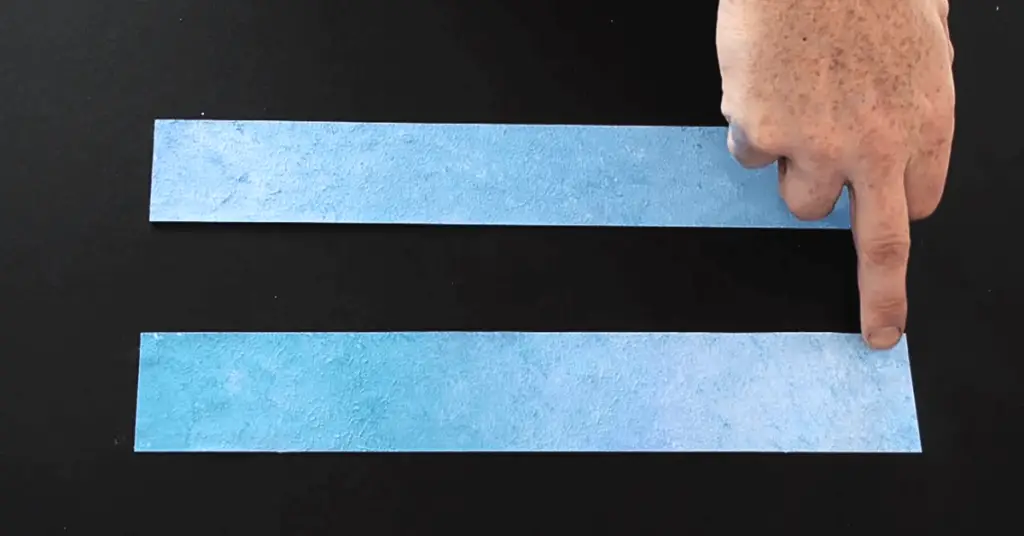
Impasto Technique
What do you mean by impasto? It is a painting technique where the paint is layered thickly on the canvas, paper or another surface, creating a textured and raised surface. The coatings are so thick that even the marks of the knife or brush are clearly visible.
Artists use this method to add depth and dimension to a painting, and it is often associated with bold and expressive brushwork. Impasto is typically achieved with thick paints like acrylics. However, it is also possible with watercolours or other media.
How to blend acrylic paint in Impasto painting?
- Apply acrylic paint thickly over the canvas using a palette knife or flat brush.
- You may add as many colors as you wish with the knife.
- Now blend these dense colors with the same brush or knife in different manners depending on your skills and requirements.
- Let the painting dry once you’re done.
Tips: Work quickly with the painting, as acrylic paint dries very fast. You may also use a medium or moist brush to extend the dry time. Moreover, the thicker the layers, the more expressive the art.
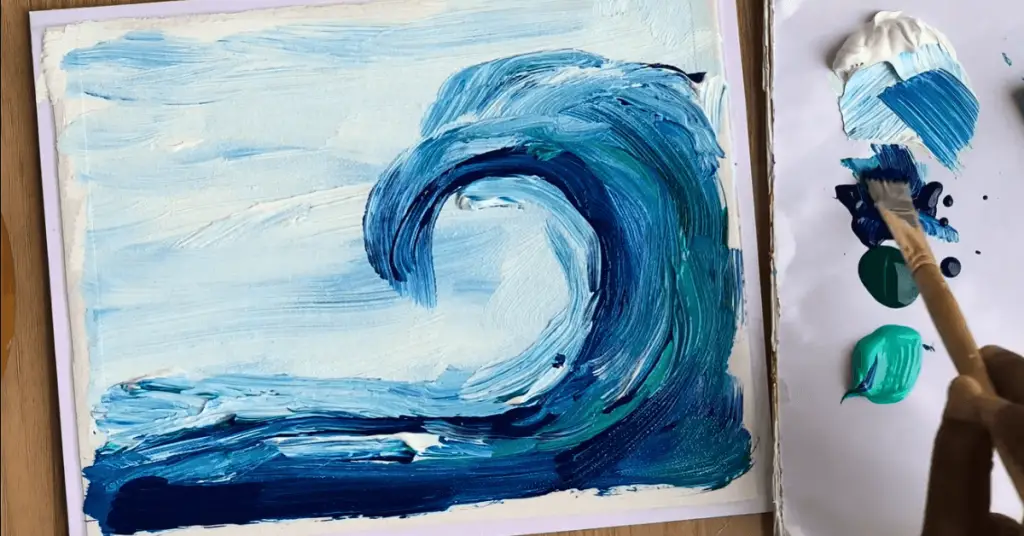
Use A Sponge
One of the best things about using a sponge for blending acrylic paint is you’ll not get those brush marks. Moreover, you’ll be able to get a smooth finish as the sponge is free of bristles.
For most of my paintings with a light background shade or a night sky scene, I prefer using a sponge for blending the colours.
How to blend acrylic paint with a sponge?
- Wet the sponge and squeeze out any extra water before using it to blend acrylic paint.
- Apply paint onto the surface you want to blend using a brush or palette knife.
- Dab the sponge into the paint and make sure it’s filled in with paint but not saturated.
- Gently pat the sponge onto the surface, using light pressure to blend the paint and create a soft and even layer.
- Rinse the sponge with water and squeeze out any excess water after each use to prevent the paint from drying on the sponge.
- Recount the procedure as needed until you achieve the desired blend and level of coverage.
- Allow the paint to dry completely before putting in additional coatings or working on top of it.
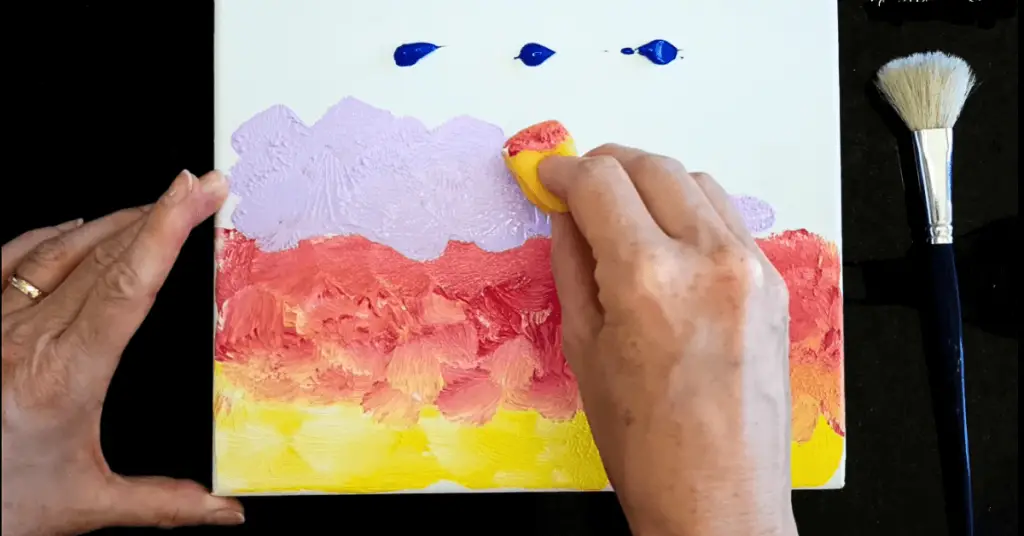
Use A Palette Knife
A palette knife is a tool often used for mixing and spreading paint. In addition, it is used for applying, scraping and removing pain from a surface. To use a palette knife for blending acrylic paint, follow the instructions below:
How to blend acrylic paint using a palette knife?
- Pick two or more acrylic colors you want to blend on your palette or canvas.
- Scoop a little amount of paint from each color onto the palette knife.
- Mix the colors on the palette knife by dragging them together until you get the desired blend.
- Scatter the blended paint onto the canvas using the flat side of the palette knife, or develop textured brush strokes by using the edge.
- Repeat the steps to count more color, blend, and layer until you get the impact you want.
- Clean the palette knife thoroughly with water and soap after usage.
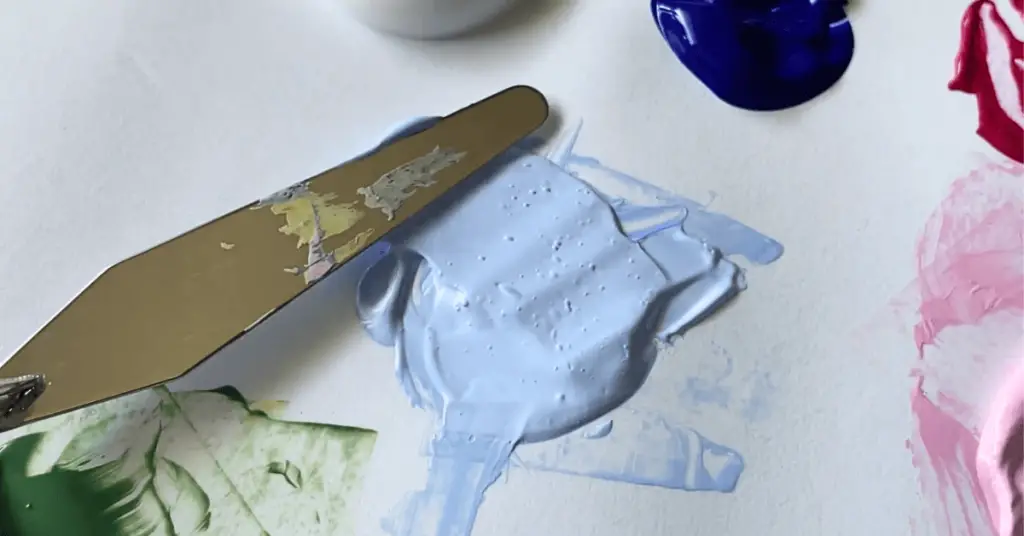
Use Glazing Technique
To blend acrylic paint using the glazing technique, you need to follow these simple steps.
Begin with a thin, transparent layer of acrylic color applied over a dry underpainting. Now, with the help of a soft brush, blend and manipulate the wet glaze to get the effects you want. Repeat layering and blending with additional glazes, allowing each layer to dry before putting in the next. Try out contrasting colors and opacities to gain the desired shade.
Tip: Always apply thin layers and avoid over-brushing to prevent the colors from becoming muddy.
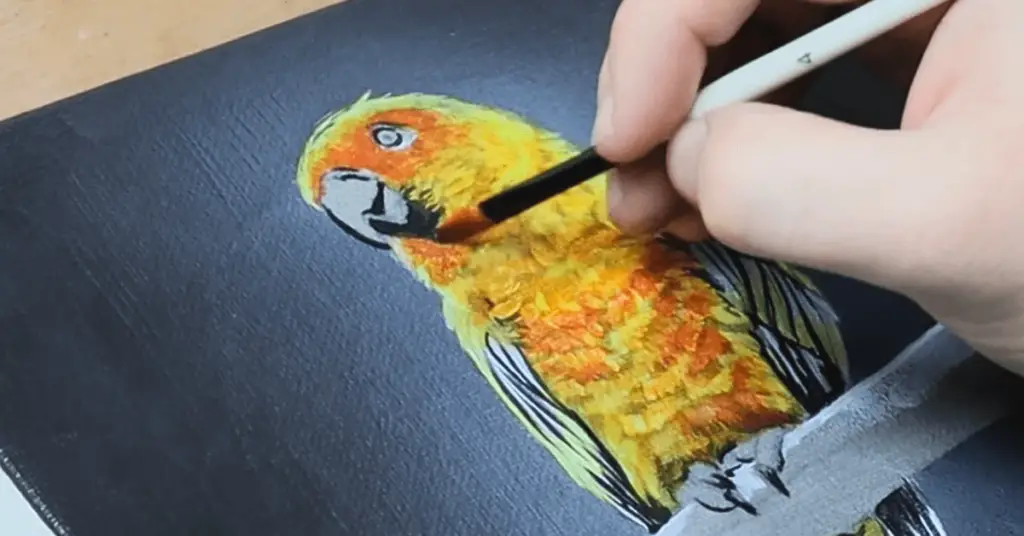
Use Pouncing Motions
If you’re looking for how to avoid brush strokes with acrylic paint, let me tell you pouncing is a blending technique that involves thumping the paint onto the surface with a rigid brush or sponge. This enables you to soften the edges of the brush strokes and blend the paint together.
But how to blend the paint with pouncing? For this purpose, load a stiff brush or sponge with paint and gently tap it onto the surface in a dabbing motion. Clean the brush, take another colour and repeat the cycle, gradually overlapping the dabs.
Tip: Keep in mind that pouncing works best when the paint is still wet.
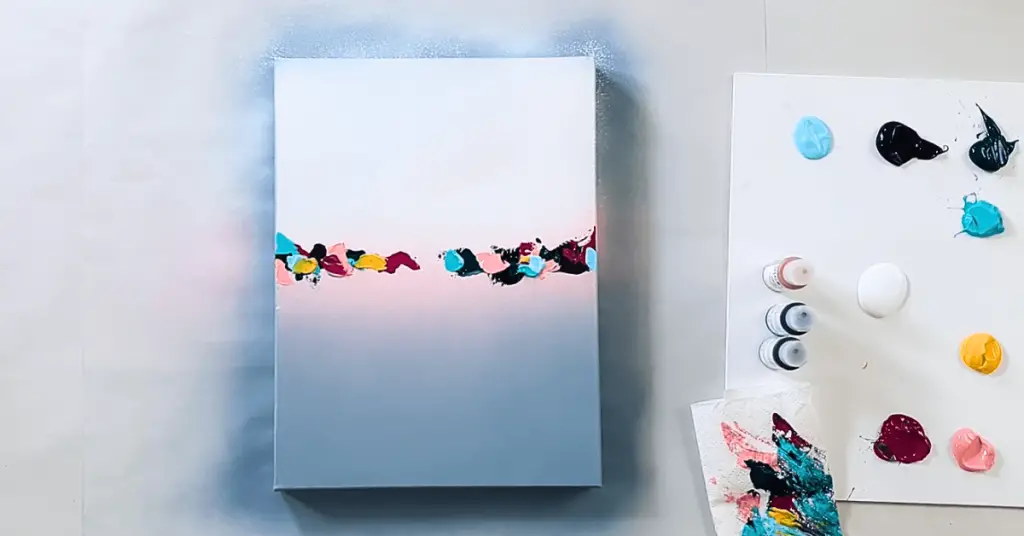
Use A Mop Brush
What do you mean by mop brush? It is a type of paint brush which has a round, fluffy shape and is made of soft and absorbent fibres that hold a lot of paint. It allows you for smooth and controlled blending.
Using a mop brush for blending acrylic paint is one of my favourite pickups. It can be used in a similar way as a sponge or regular brush, but of course, it gives you more control and provides you with better coverage.
Watercolour Technique
This method for blending is not preferable if you’re not familiar with how watercolour reacts or responds, but it can be very useful to give a new and distinct look to your art.
Simply apply a coating of watercolours over the painted surface or at the edge for a transition. You may also mix the watercolours with acrylic paint to adjust the tint of the paint.
How To Blend Acrylic Paint Like Oils?
To get acrylic paint blended like oils, you need to slow down the dry time of the paint. There are various mediums you can use to reduce the speed at which acrylic dries. Once you get enough time, you may employ various methods for blending.
FAQs
How do you blend acrylic paint smoothly?
Acrylic paint can be blended smoothly using numerous strategies, including dry and wet brushing, scumbling, stippling, glazing and using a sponge or palette knife.
What medium is best for blending acrylic paint?
There are many mediums used for blending acrylic paint. But the best medium is a retarder or an extender. They enhance the drying time of paint, letting you mix and blend colours thoroughly.
Can you use water to blend acrylic paint?
Acrylic paint is water-soluble, so you can use water to blend acrylic paint. It thins down the paint and lets the paint remain wet. A moist colour is easier to work with as compared to a dry one.
How to blend dry acrylic paint on canvas?
You may find numerous methods of blending acrylic paint on canvas but the best practice is using the right brush or sponge and knowing the accurate applications of different blending techniques.
Final Verdict
So how to blend acrylic paint? Well, as a beginner or pro in the world of painting, you’ll learn different approaches to mixing, employing and using a variety of methods, but to get these lessons to a new level, demands practice and passion.
So that was all from my side. I hope you got what you were looking for. Please leave your feedback in the comment box.
Thank You!
- How To Buff Acrylic Enamel Paint In 5 Easy Steps? - February 2, 2024
- How To Make Acrylic Paint More Opaque? 10 Effective Methods - February 1, 2024
- How To Sketch On Canvas Before Acrylic Painting? Draw Like a Pro - January 31, 2024

